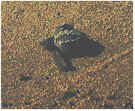 Sea turtles are graceful salt-water reptiles, well adapted to the
underwater world. With streamlined bodies and flipper-like limbs, they are able to swim
long distances in a relatively short time. Sea turtles are graceful salt-water reptiles, well adapted to the
underwater world. With streamlined bodies and flipper-like limbs, they are able to swim
long distances in a relatively short time.
When they are active, sea turtles must swim to the surface to
breathe every few minutes. When they are resting, they can remain underwater for as long
as 2 hours without breathing.
 How did they
become endangered? Although sea turtles live most of their lives in the ocean, adult
females must return to land in to lay their eggs. It is at this time that the poachers
have a field day. Though adept in the marine environment, on land, turtles are slow and
easy to capture. All a turtle thief has to do is lay in wait on a beach that is known to
be a nesting area. Each turtle can lay up to 500 eggs during a single season, and by being
patient, a poacher can have his turtle and the eggs, too. If he's lazy, all he has to do
is wait until morning, walk the beaches, and follow the footprints from the ocean to a
mound of sand, where the female has laid her eggs. How did they
become endangered? Although sea turtles live most of their lives in the ocean, adult
females must return to land in to lay their eggs. It is at this time that the poachers
have a field day. Though adept in the marine environment, on land, turtles are slow and
easy to capture. All a turtle thief has to do is lay in wait on a beach that is known to
be a nesting area. Each turtle can lay up to 500 eggs during a single season, and by being
patient, a poacher can have his turtle and the eggs, too. If he's lazy, all he has to do
is wait until morning, walk the beaches, and follow the footprints from the ocean to a
mound of sand, where the female has laid her eggs.
 The meat of the animal is
eaten, while by-products, such as turtle oil, are used in sun tanning preparations. Turtle
eggs are touted in Mexico as an aphrodisiac, and are secretly sold at beachfront
restaurants/bars. There is a 5,000 peso fine if a poacher is caught, but rarely is the
violator made to pay. His bounty is seized (unfortunately, it's usually too late for the
turtle because mama was quickly turned into soup), but oftentimes the eggs can be
incubated and hatched. The meat of the animal is
eaten, while by-products, such as turtle oil, are used in sun tanning preparations. Turtle
eggs are touted in Mexico as an aphrodisiac, and are secretly sold at beachfront
restaurants/bars. There is a 5,000 peso fine if a poacher is caught, but rarely is the
violator made to pay. His bounty is seized (unfortunately, it's usually too late for the
turtle because mama was quickly turned into soup), but oftentimes the eggs can be
incubated and hatched.
 That's
where Centro Desarrollo, Productivo, Recreativo y Ecológico (Center
for Development, Production, Recreation and Ecology) or CDPRE joins forces with other
government agencies. Once the police arrest the poacher and the eggs are seized, CDPRE
carefully incubates the eggs until they hatch by reburying them on a protected beach. The
new hatchlings are then placed in a succession of salt-water pools and fed and watched. As
they grow, they are tagged and transferred to a guarded lagoon, where they learn to hunt
their own food. Finally, the turtles are released into the ocean. This process can take up
to six years, and no turtle is released until it is capable of fending for itself. That's
where Centro Desarrollo, Productivo, Recreativo y Ecológico (Center
for Development, Production, Recreation and Ecology) or CDPRE joins forces with other
government agencies. Once the police arrest the poacher and the eggs are seized, CDPRE
carefully incubates the eggs until they hatch by reburying them on a protected beach. The
new hatchlings are then placed in a succession of salt-water pools and fed and watched. As
they grow, they are tagged and transferred to a guarded lagoon, where they learn to hunt
their own food. Finally, the turtles are released into the ocean. This process can take up
to six years, and no turtle is released until it is capable of fending for itself.
 Scientists
believe that nesting female turtles return to the same beach on which they were born.
Often sea turtles must travel long distances from their feeding grounds to their nesting
beaches. Just exactly how sea turtles
find their nesting beaches is unknown, although CDPRE is currently tagging and recording information on various species of turtles being
incubated in the sanctuary. Scientists
believe that nesting female turtles return to the same beach on which they were born.
Often sea turtles must travel long distances from their feeding grounds to their nesting
beaches. Just exactly how sea turtles
find their nesting beaches is unknown, although CDPRE is currently tagging and recording information on various species of turtles being
incubated in the sanctuary.
There are six species of turtles protected by the Endangered
Species act of 1973. These are the Green Hawksbill, Kemp's Ridley, Leatherback,
Loggerhead, Green, and Olive Ridley.
CDPRE is dedicated to educate and promote the protection of
reptiles in danger of extinction, including the green iguana, and crocodile. It is also
working through legislative reform to preserve Colima's lakes and lagoons,
whose mangrove trees are natural habitats for spoonbills, egrets, herons, pelicans,
cormorants, and many other water
birds.
 When
this writer visited the turtle sanctuary, attendant Armando Hernandez explained that CDPRE
receives no funds from the government for any of its programs.
The sanctuary exists only through
private donations, and the sanctuary will
search for people to
donate both time and money, and it is very much in need of additional
benefactors to keep the program going. When
this writer visited the turtle sanctuary, attendant Armando Hernandez explained that CDPRE
receives no funds from the government for any of its programs.
The sanctuary exists only through
private donations, and the sanctuary will
search for people to
donate both time and money, and it is very much in need of additional
benefactors to keep the program going.
The sanctuary offers camping facilities for large groups or
organizations, and special programs for students. For more information, call
this cell phone (when calling from Manzanillo): 045-313-107-4069. To visit,
take the toll road (cuota) to the town of Cuyutlan (exit to the right
just past the toll booth). Follow the signs for the "Tortugario" for
3 km. to the end of the road. The turtle sanctuary is closed Wednesday.
Entrance fee is $25 pesos for adults, $20 for children.
  An
additional activity offered are boat tours of the Cuyutlan Lagoon. If you
get there around 10 a.m. and are the first boat out, you will see dozens
of water birds, eagles, hawks, turtles, crocs (they're very shy), and
occasionally a water snake or boa. Though not connected to the sanctuary, it is a
worthwhile trip, and if you bring a bird book and binoculars, you wont be
disappointed. Cost is $40 pesos per person. Tips are gratefully accepted. An
additional activity offered are boat tours of the Cuyutlan Lagoon. If you
get there around 10 a.m. and are the first boat out, you will see dozens
of water birds, eagles, hawks, turtles, crocs (they're very shy), and
occasionally a water snake or boa. Though not connected to the sanctuary, it is a
worthwhile trip, and if you bring a bird book and binoculars, you wont be
disappointed. Cost is $40 pesos per person. Tips are gratefully accepted. For a guided
tour of the sanctuary and the lagoon, e-mail,
or click this
link
for details, and to book the "Turtle & Iguana Eco-Experience." Special
Turtle Tour Click here
for more photos and info about an ecological event held in September. |







